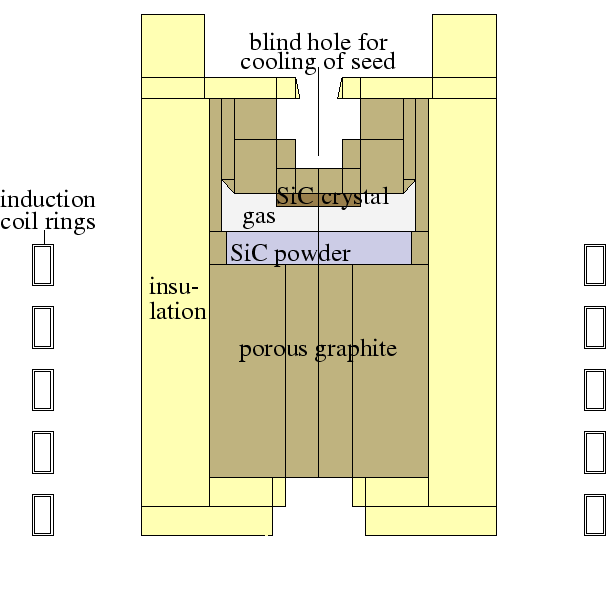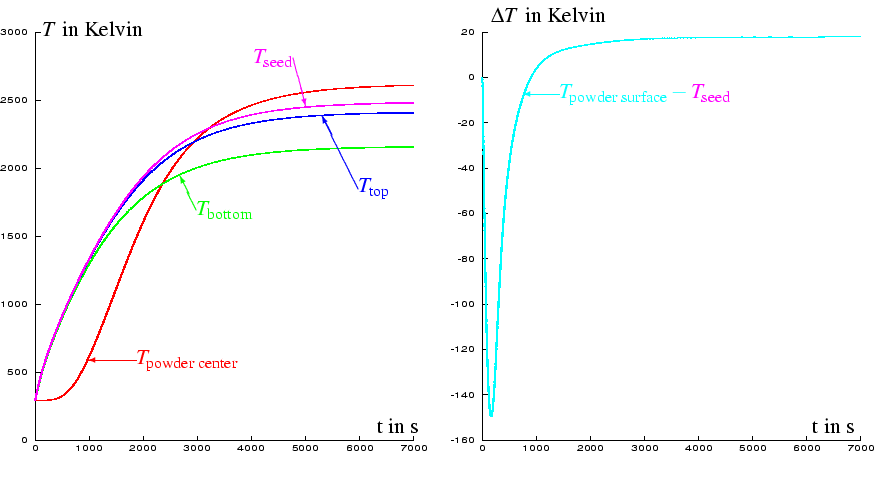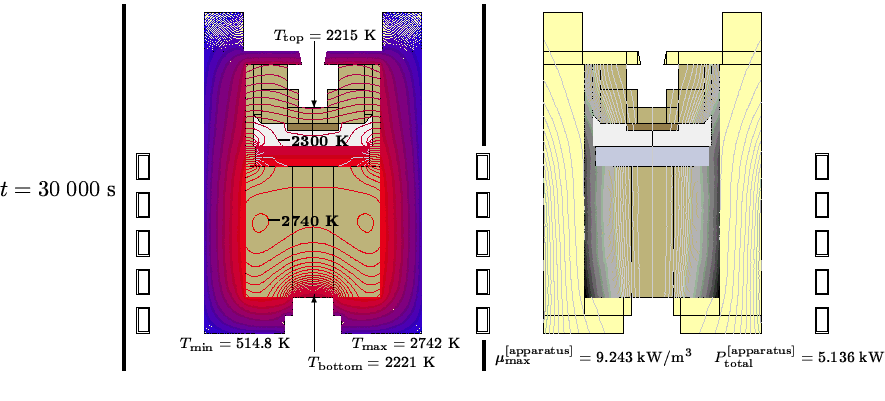|
|
|
[Contents] | [Index] |
Collaborator: O. Klein (FG 1), P. Philip (FG 1), J. Sprekels (FG 1), K. Wilmanski (FG 7)
Cooperation with: K. Böttcher, D. Schulz, D. Siche (Institut für Kristallzüchtung, Berlin)
Supported by: BMBF: ``Numerische Simulation und Optimierung der Züchtung von SiC-Einkristallen durch Sublimation aus der Gasphase'' (Numerical simulation and optimization of SiC single crystal growth by sublimation from the gas phase)
Owing to numerous technical applications in electronic and optoelectronic devices, such as lasers, semiconductors, and sensors, the industrial demand for high-quality SiC bulk single crystals remains large. It is still a challenging problem to grow sufficiently large SiC crystals with a low defect rate. Sublimation growth of SiC bulk single crystals via physical vapor transport (PVT), also known as the modified Lely method, has been one of the most successful and most widely used growth techniques of recent years.
During PVT a graphite crucible (see Fig. 1)
is placed in a low-pressure inert gas
atmosphere consisting of argon. The crucible is then intensely heated,
e.g., by induction heating , to
temperatures of some 3000 K. Inside the crucible,
polycrystalline SiC source powder is evaporated, resulting in a
gas mixture consisting of argon
and molecules made up of silicon and carbon,
Si, ![]() , and
, and ![]() being the predominant species.
The SiC single crystal grows on an SiC single crystalline seed that is
kept at a temperature below that of the SiC
source. There is also a variant of PVT where tantalum is used as
crucible material instead of graphite.
being the predominant species.
The SiC single crystal grows on an SiC single crystalline seed that is
kept at a temperature below that of the SiC
source. There is also a variant of PVT where tantalum is used as
crucible material instead of graphite.

|
Since reactor temperatures up to 3000 K make direct observations of the processes inside the growth chamber highly impractical, it is of paramount importance to have reliable theoretical models that allow the use of numerical simulation to improve the understanding of the growth procedure and to predict favorable growth conditions. Control parameters with respect to an optimization of the crystal growth are the design of the apparatus, the position of the induction coil, the heating power, and the inert gas pressure.
The physical and mathematical modeling of the growth process leads to a highly nonlinear system of coupled partial differential equations. In addition to the kinetics of a rare gas mixture at high temperatures, one has to consider heat transport by conduction and radiation, reactive matter transport through porous and granular media, and different kinds of chemical reactions and phase transitions. Moreover, several free boundaries occur in the model, e.g., due to the growing crystal and due to the evaporating source powder.
The model of the gas mixture is based on continuous mixture theory and results in balance equations for mass, momentum, and energy, including reaction-diffusion equations. The energy balance in the gas mixture is coupled to the different energy balance equations in the various solid components of the growth apparatus via suitable interface conditions ([2]).
Due to the high temperatures, it is essential to include heat transfer by radiation between surfaces of cavities in the growth apparatus. In our model we account for the radiative heat transfer using the net radiation model. The semi-transparency of the single crystal is included via the band approximation model ([3, 4]).
The heat sources caused by induction heating are computed via an axisymmetric complex-valued magnetic scalar potential that is determined as the solution of an elliptic PDE using the imposed voltage as input data. The scalar potential enables the resulting current density and thus the heat sources to be calculated. Within the research of 2001 we refined our induction heating model to ensure the correct computation of the voltage distributions to the coil rings during axisymmetric and sinusoidal modeling ([5]).
Building on previous work, within the research year 2001 the model was used to create the prototypical numerical simulation software WIAS-HiTNIHS. In its current version the software constitutes an effective tool to simulate the evolution of the temperature inside the growth apparatus including heat sources caused by induction heating, heat transport by diffusion, radiation, and constant convection in good agreement with physical experiments. It can thus be used to test and optimize geometrical setups with respect to favorable growth conditions. See [6] for an account of parameter studies varying heating voltage and coil positions.
Figures 2 and 3 depict results of numerical simulations of the heating process for the configuration of Fig. 1.
On the left-hand side of Fig. 2 it can be seen that
the evolution of the temperature in the center of the powder is quite
different from ![]() and
and ![]() , i.e. from the
temperatures that can be measured during the production process.
The temperature
, i.e. from the
temperatures that can be measured during the production process.
The temperature ![]() is omitted in the left-hand
figure, since in the depicted temperature scale it almost coincides
with
is omitted in the left-hand
figure, since in the depicted temperature scale it almost coincides
with ![]() . The evolution of the difference between
. The evolution of the difference between
![]() and
and ![]() is illustrated on the
right-hand side of Fig. 2.
is illustrated on the
right-hand side of Fig. 2.

|
The computed temperature distribution and corresponding heat sources
for the quasi-stationary state at the end of the heating process
(t=30 000 s) are presented in Fig. 3.
The temperature difference between neighboring isotherms in the
left picture is 20 K. The minimal temperature ![]() occurs at the
outside of the insulation, whereas the maximal temperature
occurs at the
outside of the insulation, whereas the maximal temperature ![]() occurs
inside the lower graphite body of the apparatus. In the right-hand
picture the difference between isolevels is 0.1 kW/m
occurs
inside the lower graphite body of the apparatus. In the right-hand
picture the difference between isolevels is 0.1 kW/m![]() ,darker regions indicating larger heat sources. The depicted heat
sources correspond to a total power
,darker regions indicating larger heat sources. The depicted heat
sources correspond to a total power ![]() kW. The maximal power density
kW. The maximal power density ![]() occurs in the lower outside corner of the
graphite.
occurs in the lower outside corner of the
graphite.

|
References:
|
|
|
[Contents] | [Index] |